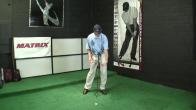My Favorite Videos
Golf Swing Sequence - How the Lower Body Works
Sorry, you need to be a member to access to this video.
Become a member here!

Struggle with coming over the top or don't know how to use your lower body in the golf swing? This video explains the golf swing sequence and the sequencing of the lower body while giving you two key drills to teach you exactly how to build a powerful lower body movement.
- Proper golf swing sequencing is what builds effortless power in the golf swing
- The hips fire first in the downswing, and simply carry the arms, shoulders & club along at first
- As the hips decelerate, the shoulders speed up - momentum is passed from hips to shoulders to arms & finally the club
- We see some of the same movement and weight shift in a baseball throw
- Golf Swing Drill: Stride & stomp the left leg during the downswing
- Once you master the stride/stomp, just lift the left heel & stomp it down without taking a step
- Make the motion smaller and smaller to integrate it into your normal swing
- The stomping motion activates the left glute & gets you loaded properly onto the left side
Golf Swing Sequence
How to sequence the golf swing is one of the most misunderstood aspects of the golf swing by most golfers. Unfortunately, it's also one of the most important. The golf swing sequence must follow a very specific progression or you will lose power in your golf swing and likely be off plane.
How the Golf Swing Sequence Effects Swing Plane
In general, the swing plane is one of the most common areas that amateur golfers struggle with when it comes to sequencing their golf swings incorrectly. The "red" segment in the video representing the shoulders is often the first part of the body that golfers will fire from the top of backswing. This leads to an "over the top" golf swing. Many golfers struggle for years doing all sorts of funny looking reroutes of the arms and club in a futile effort to fix a symptom that is caused by nothing more than a sequencing issue.
Yep, you read that right. At RotarySwing.com, we focus on fixing the CAUSE not addressing just the SYMPTOMS. So, rather than giving you an aspirin for a headache, we will go in and cut out the tumor causing the headache for a PERMANENT fix rather than a band-aid typed approach to golf instruction. So, to fix your over the top golf swing, we simply teach you how to sequence your golf swing correctly and all of a sudden, no more over the top!
The golf swing sequence in the downswing is extremely important, so make sure you focus on the drills in this golf instruction video to get your body working correctly and start hitting the ball better than ever today!

























































































































































































































































































































































































































David
Craig (Certified RST Instructor)
Michael
Chuck (Certified RST Instructor)
Albert
Craig (Certified RST Instructor)
Donlee
Craig (Certified RST Instructor)
Benson
Benson
Chris (Certified RST Instructor)
Patrick
Craig (Certified RST Instructor)
Patrick
Steven
Craig (Certified RST Instructor)
T David
Craig (Certified RST Instructor)
T David
Lewis
Craig (Certified RST Instructor)
Lance
Craig (Certified RST Instructor)
Paul
Craig (Certified RST Instructor)
Donnie
Craig (Certified RST Instructor)
James
Craig (Certified RST Instructor)
Robert
Craig (Certified RST Instructor)
Aiya
Craig (Certified RST Instructor)
Aiya
WILLIAM
Craig (Certified RST Instructor)
WILLIAM
Craig (Certified RST Instructor)
WILLIAM
Craig (Certified RST Instructor)
Edward
Craig (Certified RST Instructor)
Michel
Craig (Certified RST Instructor)
gerald
Craig (Certified RST Instructor)
Loran
Craig (Certified RST Instructor)
Rick
Craig (Certified RST Instructor)
Fred
WILLIAM
Craig (Certified RST Instructor)
Loran
R.J. (Certified RST Instructor)
phil
Craig (Certified RST Instructor)
Remington
Craig (Certified RST Instructor)
Anthony
R.J. (Certified RST Instructor)
Lowell
Craig (Certified RST Instructor)
Frank
Craig (Certified RST Instructor)
Frank
sheldon
Craig (Certified RST Instructor)
Robert
Craig (Certified RST Instructor)
John
Craig (Certified RST Instructor)
Gavin
Craig (Certified RST Instructor)
jeff
Craig (Certified RST Instructor)
jeff
Eric
Craig (Certified RST Instructor)
ciaran
René (Certified RST Instructor)
Jim